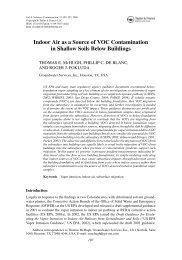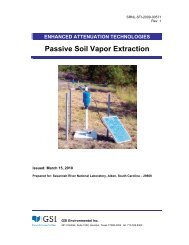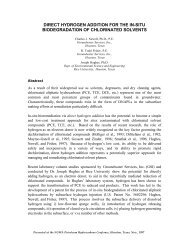Calculation and Use of First-Order Rate Constants for Monitored ...
Calculation and Use of First-Order Rate Constants for Monitored ...
Calculation and Use of First-Order Rate Constants for Monitored ...
You also want an ePaper? Increase the reach of your titles
YUMPU automatically turns print PDFs into web optimized ePapers that Google loves.
Appendix I. Uncertainty in <strong>Rate</strong> <strong>Calculation</strong>sUsing Statistics to Estimate the Time Frame toAchieve Remediation ObjectivesAs with any remediation method, one <strong>of</strong> the fundamental questionsthat arises is “How much time will be required be<strong>for</strong>e remediationobjectives are achieved?” At the current state <strong>of</strong> practice, theonly practical approach available uses a statistical analysis <strong>of</strong>long-term monitoring data from wells in the source area <strong>of</strong> thecontaminant plume. Many practitioners will calculate the Pearsonproduct moment correlation coefficient (R 2 ) <strong>for</strong> the regression usedto extract the Point Decay <strong>Rate</strong> constant (k point). If the coefficientis near one (e.g., greater than 0.9 or 0.95), the regression isaccepted as being useful in a qualitative way. There are twoproblems with this approach; it does not allow the user to select alevel <strong>of</strong> confidence <strong>for</strong> the comparison, <strong>and</strong> it does not give morevalidity to regressions with many points compared to regressionswith only a few points.The slope <strong>of</strong> the regression is the rate constant. A better approachis to calculate a confidence interval on the slope <strong>of</strong> the regression.The following data from Kolhatkar et al., 2000 will be used toillustrate this approach. They collected long-term ground-watermonitoring data from three wells at a gasoline release site in NewJersey. Their original data displayed extreme oscillations withconcentrations bouncing from a high value down to the analyticaldetection limit <strong>of</strong> 1µg/L, <strong>and</strong> then back to a high value oversequential sampling intervals. Although the scatter in the dataset is typical <strong>of</strong> the variation seen at many other sites, the influence<strong>of</strong> these outliers on the statistical estimate <strong>of</strong> the rate <strong>of</strong> attenuationwas removed by editing the data set to remove those points wherethe concentration <strong>of</strong> MTBE was less than the detection limit.Table I-1. Sources <strong>of</strong> Uncertainty in Calculated <strong>Rate</strong> <strong>Constants</strong>Type <strong>of</strong> Uncertainty Applies to Type <strong>of</strong> Effect Ways to ManageMonitoring WellLocation(horizontal <strong>and</strong>vertical location)Seasonal EffectsSeepage VelocityEstimatePoint Decay <strong>Rate</strong> (k point)Bulk Attenuation <strong>Rate</strong>Constant (k )Biodegradation <strong>Rate</strong>Constant (λ)Point Decay <strong>Rate</strong> (k point)Bulk Attenuation <strong>Rate</strong>Constant (k )Biodegradation <strong>Rate</strong>Constant (λ)Bulk Attenuation <strong>Rate</strong>Constant (k )Wells not in strongest source area maynot give repres entative indication <strong>of</strong> howlong entire plume will persist.Wells not on centerline <strong>of</strong> plume can givemis leading indications aboutconcentration pr<strong>of</strong>ile in plume.A poorly des igned monitoring wellnetwork may give misleading in<strong>for</strong>mationabout source s trength, source size, <strong>and</strong>centerline plume concentrations used <strong>for</strong>calibration.Can introduce additional s catter in dataus ed to develop k pointrate c ons tant.Ty pically not a problem as all data arecollected at the same time.Can be a problem if seas onal effects aresignificant <strong>and</strong> the data used <strong>for</strong>calibration are not c ollec ted(concentration vs. distance) at the sametime.Increases ov erall uncertainty incalculation.Characterize source with several wells.Estimate <strong>and</strong> report uncertainty in final result(estimated time to reach clean-up s t<strong>and</strong>ards ).Us e a well-designed monitoring well networkwith transects <strong>of</strong> wells in rows across theplume rather than one set <strong>of</strong> wells down theinferred centerline. Estimate <strong>and</strong> reportunc ertainty in final res ult (es timated plumelength).The source <strong>and</strong> plume need to be wellc haracterized to ensure representativemodeling res ults . Per<strong>for</strong>m sensitivity analysison model.Addres s as part <strong>of</strong> an uncertainty calculation(s ee below). For s trong seasonal effects, use<strong>of</strong> data from the same season c an bec onsidered.Not applicable.For strong seasonal effects, use data froms ame s eas on to help ensure representativ emodeling res ults . Per<strong>for</strong>m sensitivity analysison model.Average results from multiple seepageestimates along plume centerline. Improv eseepage velocity estimate. Estimate <strong>and</strong>report uncertainty in final result (estimatedplume length).PlumeHeterogeneityAll rate constantc alc ulationsIncreases apparent uncertainty.<strong>Use</strong> worst-case data. <strong>Use</strong> transects toc apture plume heterogeneity. For regressionbased rate cons tants (k <strong>and</strong> k point), estimate<strong>and</strong> report uncertainty in final result. Formodeling studies designed to determine λ,per<strong>for</strong>m sensitivity analy sis on model byc hanging k ey variables to their upper <strong>and</strong>lower expected range <strong>and</strong> evaluate howmodeling res ults c hange.12






